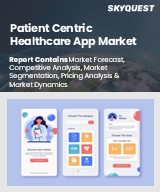
세계의 환자 중심 헬스케어 앱 시장 규모는 2023년에 146억 달러로 평가되며, 예측 기간(2025-2032년)의 CAGR은 17.7%로, 2024년 171억 8,000만 달러에서 2032년에는 632억 9,000만 달러로 성장할 전망입니다.
세계 환자 중심 헬스케어 앱 시장은 모바일 기기를 통해 접근할 수 있는 개인화된 헬스케어 툴에 대한 수요 증가에 힘입어 큰 폭으로 성장하고 있습니다. 환자들은 현재 편리한 상태 모니터링과 의료 서비스 프로바이더와의 효과적인 커뮤니케이션을 촉진하는 솔루션을 원하고 있습니다. 이러한 수요로 인해 개발자들은 사용자 중심의 설계와 치료 순응도를 높일 수 있는 인게이지먼트 기능에 집중하고 있습니다. 실시간 피드백과 원격 모니터링, 맞춤형 개입을 지원하는 플랫폼에 대한 투자는 환자 참여를 지지하는 규제 프레임워크에 힘입어 증가 추세에 있습니다. 주요 동향으로는 파소나이즈드 추천을 위한 인공지능의 통합, 전자의무기록과의 상호운용성 강화, 웨어러블 기술의 발전 등이 있습니다. 원격의료 솔루션, 이해관계자간의 협력적 노력, 데이터 프라이버시와 사용자 경험에 대한 강조는 다양한 환자층에 널리 보급되기 위해 필수적입니다.
Global Patient Centric Healthcare App Market size was valued at USD 14.6 billion in 2023 and is poised to grow from USD 17.18 billion in 2024 to USD 63.29 billion by 2032, growing at a CAGR of 17.7% during the forecast period (2025-2032).
The global patient-centric healthcare app market is experiencing significant growth, propelled by an increasing need for personalized health management tools accessible via mobile devices. Patients are now demanding solutions that facilitate convenient condition monitoring and effective communication with healthcare providers. This demand encourages developers to focus on user-centered design and engagement features that promote adherence to treatment. Investment in platforms that support real-time feedback, remote monitoring, and customized interventions is on the rise, bolstered by regulatory frameworks endorsing patient engagement. Key trends include the integration of artificial intelligence for personalized recommendations, enhanced interoperability with electronic health records, and advances in wearable technology. Telehealth solutions, collaborative efforts among stakeholders, and a strong emphasis on data privacy and user experience are essential for widespread adoption across diverse patient demographics.
Top-down and bottom-up approaches were used to estimate and validate the size of the Global Patient Centric Healthcare App market and to estimate the size of various other dependent submarkets. The research methodology used to estimate the market size includes the following details: The key players in the market were identified through secondary research, and their market shares in the respective regions were determined through primary and secondary research. This entire procedure includes the study of the annual and financial reports of the top market players and extensive interviews for key insights from industry leaders such as CEOs, VPs, directors, and marketing executives. All percentage shares split, and breakdowns were determined using secondary sources and verified through Primary sources. All possible parameters that affect the markets covered in this research study have been accounted for, viewed in extensive detail, verified through primary research, and analyzed to get the final quantitative and qualitative data.
Global Patient Centric Healthcare App Market Segments Analysis
Global Patient Centric Healthcare App Market is segmented by Technology, Operating System, Application, End-User and region. Based on Technology, the market is segmented into Phone-based Apps, Wearable Apps and Web-based Apps. Based on Operating System, the market is segmented into Android, iOS, Windows and Others. Based on Application, the market is segmented into Wellness Management and Disease & Treatment Management. Based on End-User, the market is segmented into Hospitals, Home Use and Clinics. Based on region, the market is segmented into North America, Europe, Asia Pacific, Latin America and Middle East & Africa.
Driver of the Global Patient Centric Healthcare App Market
The global patient-centric healthcare app market is experiencing significant growth due to the increasing demand for preventive and personalized care. Consumers are looking for tools that empower them to take control of their health, opting for solutions that provide customized recommendations, progress tracking, and immediate notifications. Applications that adapt to user behavior, consider medical history, and integrate data from wearable devices deliver a more interactive and effective experience. This emphasis on personalization not only fosters the creation of smarter and more adaptable platforms but also enhances long-term user engagement and satisfaction, further propelling market expansion.
Restraints in the Global Patient Centric Healthcare App Market
The sensitive nature of health data presents considerable challenges for the Global Patient Centric Healthcare App market, particularly regarding privacy protection. Issues such as data breaches, unauthorized access, and failure to comply with regulations like HIPAA or GDPR can undermine user trust, ultimately affecting technology adoption. Developers must prioritize incorporating robust encryption, obtaining user consent, and ensuring transparency in data management, as users rightfully demand these safeguards. However, adhering to these requirements can significantly inflate development costs and introduce potential legal liabilities, subsequently restricting market entry and impeding the scalability of apps aimed at enhancing patient-centered care.
Market Trends of the Global Patient Centric Healthcare App Market
The Global Patient Centric Healthcare App market is witnessing a transformative trend as the integration of artificial intelligence (AI) technologies gains momentum, facilitating hyper-personalized care experiences for users. These advanced applications are designed to continuously analyze individual patient behaviors, preferences, symptoms, and clinical histories, thereby tailoring care decisions and wellness routines effectively. AI-driven features such as chatbots, symptom checkers, and recommendation engines empower patients to make informed choices while concurrently alleviating the burden on clinical staff. This shift towards continuous patient engagement and proactive health management is particularly prominent in chronic care and mental health sectors, indicating a revolutionary change in healthcare delivery and accessibility.